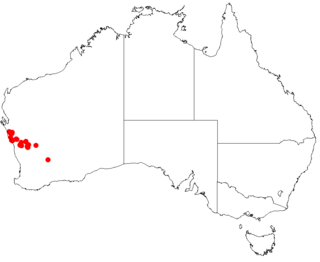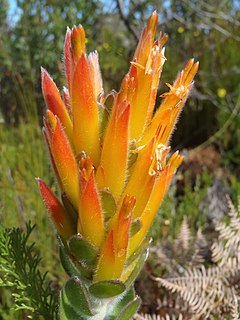
Hairy cell leukemia is an uncommon hematological malignancy characterized by an accumulation of abnormal B lymphocytes. It is usually classified as a subtype of chronic lymphocytic leukemia (CLL). Hairy cell leukemia makes up about 2% of all leukemias, with fewer than 2,000 new cases diagnosed annually in North America and Western Europe combined.

Banksia goodii, commonly known as Good's banksia, is a species of prostrate shrub that is endemic to a small area in the south-west of Western Australia. It has densely hairy stems, wavy, oblong to egg-shaped leaves with irregularly serrated margins, rusty-brown flowers and hairy fruit. It grows in low forest and woodland near Albany and is listed as "endangered".

Banksia lanata is a species of shrub that is endemic to a restricted area of Western Australia. It has linear leaves, pale cream-coloured flowers in a head with whitish bracts at the base and later up to fifty elliptical follicles in each head.

Banksia horrida, commonly known as prickly dryandra, is a species of shrub that is endemic to Western Australia. It has hairy stems, linear, pinnatifid leaves with sharply pointed teeth on the edges, up to sixty cream-coloured flowers in each head and hairy, egg-shaped follicles.

Banksia heliantha, commonly known as oak-leaved dryandra, is a species of shrub that is endemic to Western Australia. It has hairy stems, serrated, egg-shaped to wedge-shaped leaves, golden yellow flowers and partly woolly follicles.

Persoonia rigida, commonly known as the rigid-, hairy- or stiff geebung, is a species of flowering plant in the family Proteaceae and is endemic to south-eastern Australia. It is an erect to low-lying shrub with hairy young branchlets, lance-shaped to spatula-shaped leaves that are hairy when young, and yellow flowers borne in groups of up to twenty on a rachis up to 90 mm (3.5 in) long that continues to grow after flowering.

Persoonia hirsuta, commonly known as the hairy geebung or hairy persoonia, is a plant in the family Proteaceae and is endemic to eastern New South Wales. It is a hairy, spreading to low-lying shrub with linear, lance-shaped or spatula-shaped leaves and yellow or orange flowers arranged singly or in groups of up to ten on a rachis up to 20 mm (0.79 in) long.
Persoonia pertinax is a species of flowering plant in the family Proteaceae and is endemic to Western Australia. It is an erect to spreading shrub with hairy young branchlets, twisted linear leaves, and hairy yellow flowers borne in groups of up to ten on a rachis up to 60 mm (2.4 in) long.

Persoonia oblongata is a plant in the family Proteaceae and is endemic to New South Wales. It is an erect to spreading shrub with narrow elliptic to broad egg-shaped leaves and yellow flowers on long, curved pedicels and is found from the lower Blue Mountains, west to Rylstone.

Persoonia fastigiata is a plant in the family Proteaceae and is endemic to the Northern Tablelands of New South Wales. It is a small, erect to spreading shrub with linear leaves and hairy flowers arranged singly or in groups of up to five on a rachis up to 10 mm (0.39 in) long.

Persoonia curvifolia is a plant in the family Proteaceae and is endemic to central New South Wales. It is an erect to spreading shrub with linear leaves and somewhat hairy yellow flowers.

Persoonia cuspidifera is a species of flowering plant in the family Proteaceae and is endemic to northern New South Wales. It is an erect shrub with spatula-shaped leaves and greenish yellow, tube-shaped flowers in groups of up to twenty-five.

Persoonia hexagona is a species of flowering plant in the family Proteaceae and is endemic to the south-west of Western Australia. It is an erect, spreading shrub with branchlets that are densely hairy when young, linear, sharply pointed leaves and bright yellow, hairy flowers borne singly or in groups of up to ten on a rachis up to 40 mm (1.6 in) long.
Persoonia pentasticha is a species of flowering plant in the family Proteaceae and is endemic to the south-west of Western Australia. It is an erect, spreading shrub with hairy young branchlets, linear leaves with five narrow, longitudinal grooves, and hairy yellow flowers borne in groups of up to fifteen on a rachis up to 45 mm (1.8 in) long.
Persoonia papillosa is a species of flowering plant in the family Proteaceae and is endemic to a restricted area in the west of Western Australia. It is a small, erect shrub with hairy young branchlets, linear leaves with six prominent parallel veins, and hairy flowers borne in groups of up to twenty on a rachis up to 60 mm (2.4 in) long.
Persoonia kararae is a species of flowering plant in the family Proteaceae and is endemic to the Perenjori district of Western Australia. It is an erect, spreading shrub with densely hairy branchlets, linear leaves and yellow flowers in groups of up to ten on a rachis up to 10 mm (0.39 in) long.

Persoonia saccata, commonly known as snottygobble, and cadgeegurrup in indigenous language, is a plant in the family Proteaceae and is endemic to the south-west of Western Australia. It is usually an erect shrub and has linear leaves and groups of up to fifty or more irregularly shaped, yellow flowers which are hairy on the outside. It usually grows in woodland dominated by jarrah, marri or large Banksia species.
Persoonia manotricha is a species of flowering plant in the family Proteaceae and is endemic to Western Australia. It is an erect shrub with hairy young branchlets, more or less cylindrical leaves and greenish yellow flowers in groups of up two to eight on a rachis 2–15 mm (0.079–0.591 in) long. It is similar to P. bowgada and P. hexagona but has longer pedicels than P. bowgada and differently grooved leaves from P. hexagona.

Isopogon alcicornis, commonly known as the elkhorn coneflower, is a plant in the family Proteaceae and is endemic to part of the South Coast Western Australia. It is a low shrub with pinnately-lobed leaves and oval heads of hairy, white or pink flowers.

Mimetes pauciflorus, the three-flowered pagoda, is an evergreen, shyly branching, upright shrub of 2–4 (6½–13 ft) high, from the family Proteaceae. It has narrowly to broadly oval leaves of 2½–4 cm (1.0–1.6 in) long and ¾–2 cm (0.3–0.8 in) wide, on the upper parts of the branches, the lower parts leafless with a reddish brown bark. The inflorescences at the top of the shoots are cylinder-shaped, 10–40 cm (4–16 in) long and contain forty to one hundred twenty densely crowded flower heads, at a steep upward angle, hiding a crest of very small, almost vertical leaves. The flower heads each consist of three, rarely four individual flowers. The flowers are tightly enclosed by four or five orange-yellow, fleshy, pointy, lance-shaped involucral bracts, and three orange-yellow, 4–5½ cm (1.6–2.4 in) long bracteoles. It grows on always moist, south-facing slopes in the southern coastal mountains of South Africa. Flowers can be found from August to November, with a peak in September.














